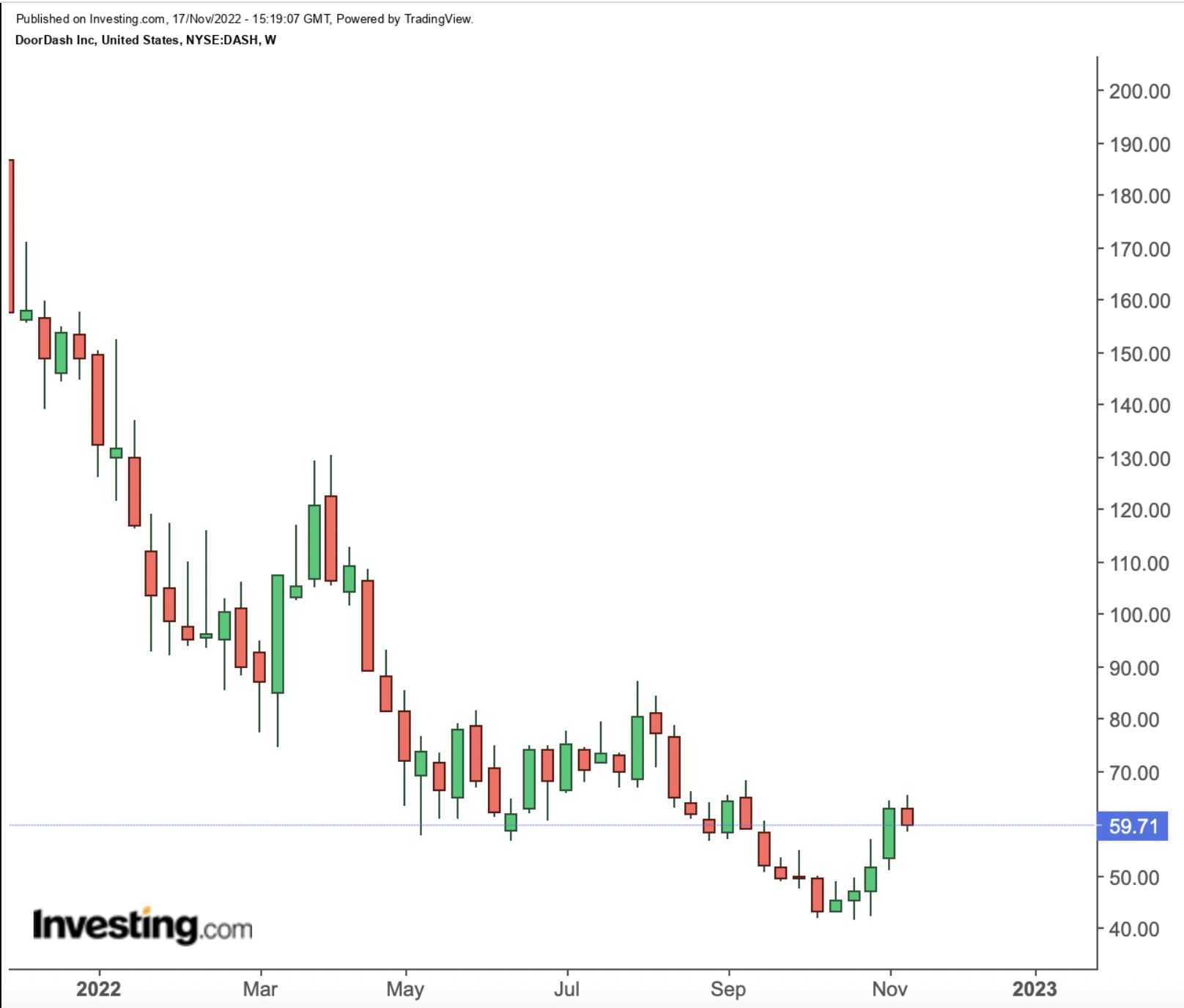- DASH remains unprofitable, yet still has an enterprise value near $20 billion
- Skeptics argue the business model, over time, simply won’t be able to work
- But the opportunity here is huge, and profitability is obscured somewhat by current investments. If this works, it will work big
On its face, DoorDash Inc (NYSE:DASH) looks like a screaming sell. Even with DASH down 75% from its all-time high, the company still has a market capitalization of $23 billion, and an enterprise value of about $19 billion.
Yet, including guidance for the fourth quarter, this year DoorDash should generate about $350 million in adjusted EBITDA (earnings before interest, taxes, depreciation and amortization). But that figure doesn’t tell the whole story. Through the first three quarters, the company has booked $612 million in stock-based compensation. Accounting for that dilution — as investors should — the company isn’t profitable even on that generous basis.
But short term and long term, the story is better than those headline numbers suggest. Near-term profits are being obscured by investments in growth across the business. And the long-term opportunity here is enormous.
DoorDash still has a lot of work left to do, certainly. And particularly after a recent rally, there’s an argument for patience. But in a blue-sky scenario, DASH stock could be a huge, huge winner.

Source: Investing.com
Hidden Profits
In the third quarter, DoorDash generated $1.7 billion in revenue. Adjusted EBITDA was $87 million; stock-based comp was $251 million.
Adding back share issuance, DoorDash’s EBITDA actually was a loss of $164 million — nearly 10% of revenue. Its loss from operations on a GAAP (Generally Accepted Accounting Principles) basis in the quarter was $308 million, 18% of revenue. And that loss, in fact, tripled year over year.
Again, the consolidated numbers show an unprofitable business. Worse, they show a business that is losing more money as it generates higher revenue.
But, in fact, the core North American food delivery business actually was profitable in the quarter. Wolt, acquired last year, posted an adjusted EBITDA loss of $65 million. In the Q3 shareholder letter, DoorDash said that its U.S. restaurant marketplace posted a contribution profit (revenue less direct expenses) of $595 million; the consolidated figure was $420 million.
Add back those $175 million in losses to the aforementioned $164 million dilution-adjusted loss, and in U.S. food delivery DoorDash indeed was profitable, if modestly so. But that modest profit is coming on the back of impressive growth: two years ago, contribution profit in the U.S. food delivery business was more than 50% lower.
What DoorDash is doing now is trying to replicate that success elsewhere. Wolt moved the company into Europe. The company is expanding into retail. It’s selling ads. It offers DoorDash Storefront, an online ordering system.
Those businesses on the whole are losing money. And they’re pushing the consolidated company into the red. But that doesn’t mean that DoorDash can’t turn a profit. For now, it’s simply willing not to.
The Long-Term Opportunity
That makes sense in the context of the opportunity here. DoorDash has dominant market share in U.S. food delivery. The European market can be nearly as attractive.
Retailers can use DoorDash to boost their own revenue and further satisfy customers. The marginal cost to DoorDash, over time, of those revenues, should be relatively small once the driver base is intact. Ads have been a huge revenue source for other platform businesses — Amazon.com (NASDAQ:AMZN) being a notable example — and should boost profitability over time.
If DoorDash can even partially translate its success in U.S. food delivery to new end markets and new geographies, the upside is enormous. Each incremental dollar in contribution profit turns into adjusted EBITDA at high margins. Each dollar in adjusted EBITDA turns into free cash flow at something close to the after-tax rate. This is a business that, at maturity, should be exceptionally profitable. But maturity remains a long ways off.
The Risks Are Real
But it bears repeating: There is a lot of work left to do, and a lot for DoorDash still to prove. The food delivery model has its fair share of critics, who say DoorDash both charges restaurants too much and pays drivers too little.
The move into Europe is fraught with trouble, between macroeconomic conditions on the Continent, the stronger dollar and established competition. Wolt has focused on underserved markets, leaving it potentially shut out of the most lucrative cities.
Convenience and retail seem like attractive markets, but may not have the upside management sees. Amazon continues to improve its logistics network; the relative edge of delivery from DoorDash simply may not be high enough to justify ongoing fees.
There are short-term risks to the stock as well. DASH has rallied since last week’s earnings report, but investors have been more willing to buy speculative stocks in recent weeks as well. That optimism may reverse. Overall, the market still seems nervous — and shares of unprofitable $23-billion companies rarely do well in nervous markets, no matter the size of the long-term opportunity.
As a result, it’s difficult to pound the table too hard for DASH just yet. But investors shouldn’t write the stock off, either. DoorDash still has many years of growth ahead, and that’s more important than how much money it lost last quarter.
Disclaimer: As of this writing, Vince Martin has no positions in any securities mentioned.
